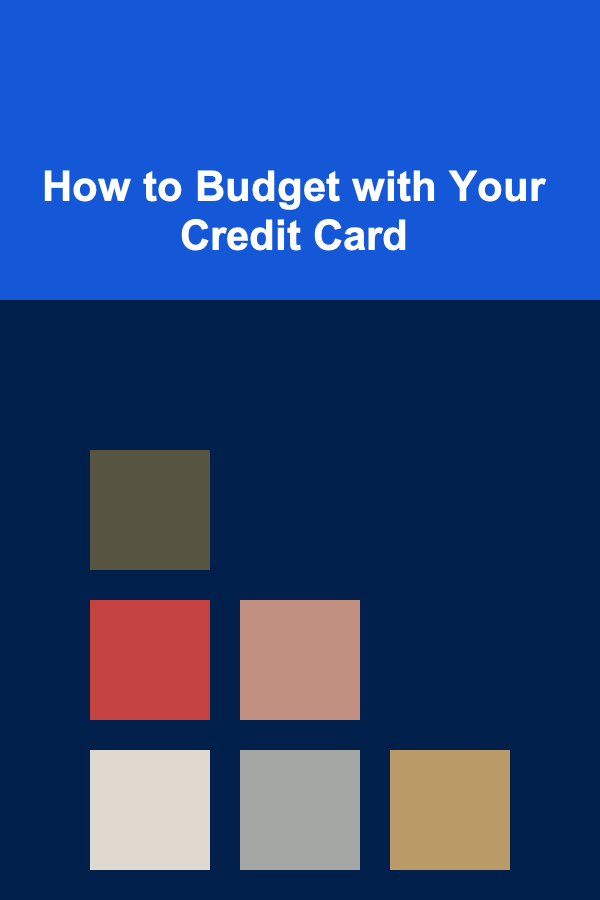
How to Budget with Your Credit Card
ebook include PDF & Audio bundle (Micro Guide)
$12.99$8.99
Limited Time Offer! Order within the next:

Managing personal finances is a critical skill for financial stability and long-term wealth-building. Credit cards, when used wisely, can be powerful tools that not only provide convenience and security but also help you manage your budget effectively. However, without discipline and understanding, credit cards can lead to debt accumulation, high interest payments, and financial stress.
This comprehensive article explores how to budget effectively with your credit card. It covers strategies for integrating credit cards into your budgeting system, ways to avoid common pitfalls, and how to leverage credit card benefits responsibly. By understanding these principles, you can harness the power of credit cards to improve your financial health rather than harm it.
Understanding Credit Cards and Budgeting
Before diving into budgeting techniques, it's important to clarify the role of credit cards within personal finances.
What Is a Credit Card?
A credit card is a financial tool issued by banks or credit institutions that allows you to borrow money up to a certain limit to make purchases or pay bills. The amount you spend must be paid back, either in full by the billing cycle due date or over time with interest. Credit cards offer:
- Convenience: Easy payment method accepted worldwide.
- Security: Fraud protection and dispute resolution.
- Rewards: Points, cash back, travel perks.
- Credit Building: Timely payments build credit score.
Budgeting with Credit Cards: Why Does It Matter?
Credit cards are not free money --- they are a loan you repay. Budgeting with credit cards means tracking spending carefully to avoid overspending, managing payments to prevent interest charges, and using the card to optimize your cash flow.
Key reasons to budget with credit cards include:
- Avoiding Debt: Overspending on credit cards leads to debt with potentially high-interest rates.
- Improving Credit Score: Responsible usage and timely payments improve creditworthiness.
- Maximizing Rewards: Understanding your spending patterns lets you maximize cashback and rewards.
- Maintaining Financial Control: Budgeting helps ensure your expenses do not exceed income.
Step 1: Create a Realistic Budget
The foundation for budgeting with your credit card is having a clear, realistic monthly budget.
Track Your Income
Begin by calculating your total monthly income from all sources, including salary, freelance work, investments, etc.
List Your Expenses
Categorize your expenses into:
- Fixed Expenses: Rent/mortgage, utilities, loan payments, insurance.
- Variable Expenses: Groceries, transportation, dining out, entertainment.
- Discretionary Expenses: Shopping, hobbies, vacations.
Set Spending Limits
Assign realistic limits to each category based on your income and financial goals. This helps control credit card spending.
Use Budgeting Tools
Consider using budgeting apps like Mint, YNAB, or spreadsheets to monitor your income and expenses in real time. These tools can also link to your credit card accounts to track spending automatically.
Step 2: Link Your Credit Card to Your Budget
Decide What to Put on Your Credit Card
Not all expenses need to go on your credit card. Choose categories that benefit most from credit card usage, such as:
- Recurring monthly bills (utilities, subscriptions) for easy tracking and rewards.
- Groceries and gas for cashback or points.
- Travel expenses to maximize travel rewards.
Avoid using credit cards for impulse discretionary purchases unless you can pay them off immediately.
Separate Credit Card Spending from Other Payment Methods
If you use multiple payment methods (cash, debit, other cards), track credit card spending separately in your budget for clarity and control.
Set Spending Alerts
Most credit cards and banking apps allow you to set alerts for transactions or when you approach a certain spending limit. This helps you stay within your budget.
Step 3: Manage Payments Strategically
Pay Your Statement Balance in Full Each Month
To avoid interest charges, pay the full statement balance by the due date. Interest can quickly accumulate if you only pay the minimum.
Use Automatic Payments
Set up automatic payments for at least the minimum amount to avoid late fees and protect your credit score.
Monitor Your Payment Dates
Be aware of billing cycle dates and due dates to plan your spending and payments effectively.
Consider Biweekly Payments
If cash flow allows, make payments more frequently than once a month to reduce balance faster and minimize interest if carrying balances.
Step 4: Use Your Credit Card to Optimize Cash Flow
Take Advantage of Grace Periods
Credit cards typically offer a grace period where purchases made during the billing cycle do not incur interest if paid in full by the due date. Use this to manage cash flow by delaying payments for up to 30 days interest-free.
Use Credit Cards for Large Purchases
For planned large purchases, using a credit card can offer purchase protection, extended warranties, and rewards points. Ensure you can pay it off promptly to avoid interest.
Leverage Rewards and Cashback
Understand your credit card rewards structure and plan your spending accordingly:
- Use cards with high cashback rates on your top spending categories.
- Redeem points or cashback strategically for maximum value.
- Avoid spending extra just to earn rewards, as this negates budget discipline.
Step 5: Avoid Common Pitfalls When Budgeting with Credit Cards
Pitfall 1: Overspending Due to Credit Limit
Just because your credit limit is high does not mean you should spend up to it. Set personal limits lower than the credit limit to avoid impulse overspending.
Pitfall 2: Ignoring Interest Rates
High interest rates can make carrying balances costly. If you must carry a balance, look for low-interest or promotional 0% APR cards.
Pitfall 3: Missing Payments
Late payments hurt your credit score and incur fees. Use reminders or automatic payments to stay on track.
Pitfall 4: Not Tracking All Spending
Some small purchases may be easy to forget but can add up. Track all credit card spending diligently.
Step 6: Monitor and Adjust Your Budget Regularly
Review Your Credit Card Statements Monthly
Carefully review monthly statements for unauthorized charges, spending patterns, and opportunities to cut costs.
Adjust Budget Categories
If you consistently overspend in a category, reassess whether the budget limit is realistic or if you need to cut back.
Evaluate Credit Card Benefits Annually
Credit cards change terms, fees, and rewards. Reevaluate your cards yearly to ensure they align with your spending habits and financial goals.
Step 7: Build an Emergency Fund and Use Credit Cards Responsibly
Importance of an Emergency Fund
An emergency fund with 3-6 months of living expenses protects you from relying on credit cards for unexpected costs, which can spiral into debt.
Use Credit Cards as a Financial Tool, Not a Crutch
Treat credit cards as a means of managing cash flow, earning rewards, and building credit --- not as extra income.
Advanced Strategies for Budgeting with Credit Cards
Strategy 1: Envelope System Adapted for Credit Cards
The envelope system divides cash into spending categories. Adapt this by allocating a credit card spending limit per category monthly and sticking to it strictly.
Strategy 2: Zero-Based Budgeting
Assign every dollar of your income a purpose, including credit card payments. This prevents "leftover" money from being spent impulsively.
Strategy 3: Multiple Credit Cards for Different Budgets
Use different cards for specific spending categories to track and manage budgets more easily while maximizing category-specific rewards.
Psychological Tips to Help Budget with Credit Cards
Keep Credit Cards Out of Sight
Reducing the ease of impulse spending by keeping cards out of immediate reach.
Visualize Your Debt
Use graphs or debt tracking apps to visualize how spending affects your credit card balance over time.
Reward Yourself Responsibly
Set small rewards for meeting budget goals to stay motivated without breaking your budget.
Conclusion
Budgeting with credit cards requires a disciplined approach that combines understanding your income and expenses, carefully tracking spending, making timely payments, and strategically using the credit card's benefits. By following the steps outlined above, you can transform your credit card from a potential financial hazard into a powerful tool that supports your financial health, builds your credit, and helps you achieve your goals.
Remember, the key is control and awareness: only spend what you can afford to repay, track every transaction, and always prioritize paying off your balance in full. With these habits, budgeting with a credit card becomes not just manageable but advantageous.
If you'd like, I can help you design a personalized budgeting template or walk you through selecting the best credit card for your spending habits!
Reading More From Our Other Websites
- [Home Holiday Decoration 101] How to Style Your Mantel with Holiday Decorations
- [Home Budget 101] How to Budget for Car Insurance Without Overspending
- [Organization Tip 101] Solar Garden Lights vs. Traditional Outdoor Lighting: Which is Better?
- [Stamp Making Tip 101] Best Stamp Making for Wedding Invitations: Creating a Truly Unique Touch
- [Home Security 101] How to Safeguard Your Home's Entry Points Effectively
- [Gardening 101] Step‑by‑Step Guide: Installing a Vertical Garden Kit on a Balcony
- [Organization Tip 101] How to Organize Craft Supplies with Less Clutter
- [Home Holiday Decoration 101] How to Create DIY Holiday Snow Globes to Add a Touch of Magic to Your Space
- [Home Pet Care 101] How to Keep Your Pet Calm During Thunderstorms: Tips for Reducing Anxiety
- [Needle Felting Tip 101] How to Develop a Signature Needle Felting Style Inspired by Traditional Folk Art Motifs

How to Organize Personal Mementos by Theme
Read More
How to Stage a Small Apartment for Maximum Appeal
Read More
How To Master Traditional Interior Design
Read More
The Step-by-Step Guide to Effective Networking
Read More
How to Integrate To-Do Lists with Time Blocking for Focused Work
Read More
10 Tips for Preventing HVAC Mold Growth in Homes
Read MoreOther Products

How to Organize Personal Mementos by Theme
Read More
How to Stage a Small Apartment for Maximum Appeal
Read More
How To Master Traditional Interior Design
Read More
The Step-by-Step Guide to Effective Networking
Read More
How to Integrate To-Do Lists with Time Blocking for Focused Work
Read More